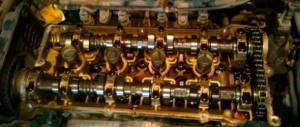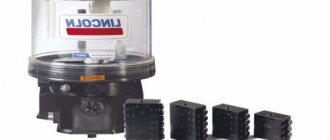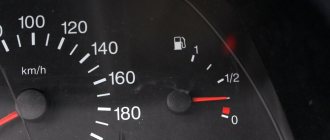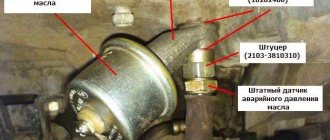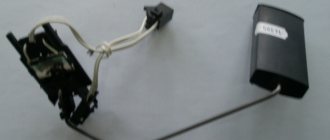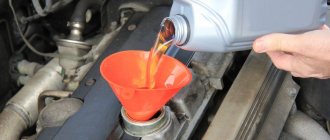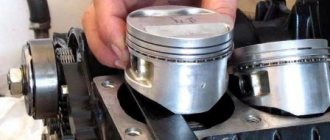Where is the engine oil dipstick located?
Dipstick for measuring oil fluid
If you decide to check the level of oil material in a car, then you need to find a special “sensor”. The dipstick for measuring engine oil is usually located on the right or left of the engine, near the oil filler plug.
The probe is equipped with a comfortable small handle and it can be of different shapes. The color of this handle is usually red, yellow or orange. If you cannot find the dipstick near the engine, then pay attention to the engine cylinder block. The handle usually sticks out from this block.
Important: In a car with an automatic transmission, there are two metal rods near the engine: 1 - for checking the oil level in the engine, 2 - directly in the gearbox itself. Don't mix up these rods. It is prohibited to insert a rod from the engine compartment into the gearbox and vice versa. Oily material from the gearbox must not get into the engine compartment. This can lead to car failure.
How to check engine oil level
Check your car's manual. The documentation provides detailed instructions on how to properly prepare and check the engine oil:
- Is it necessary to warm up the engine?
- how long to wait until the lubricant drains into the crankcase: 5 or 20 minutes. The duration is affected by the design of the engine and the shape of the sump;
- which vehicle functions should be deactivated. For example, before working in the Renault engine compartment, you need to disable the Start and Stop function.
Before measuring the amount of oil, it is important to place the machine on a flat, horizontal surface. This applies to all cars. A slight tilt of the crankcase will give incorrect readings.
Further actions depend on the vehicle's equipment. Most machines have a dipstick to control the amount of lubricant. Let's take a closer look at how to work with it. We'll talk about the electronic level gauge later.
- The dipstick is located under the hood. It is easy to find by its red or yellow handle. Pull out the dipstick and wipe it with a lint-free cloth or cloth. There should be no drops left on the meter.
- Insert the oil gauge into the dipstick tube until it stops. In some engine designs, the dipstick must be turned.
- After a minute, remove the dipstick. Look where the oil lip is located. Normally, it should be in the middle of the measurement scale, i.e. between maximum and minimum.
Similar article 126 VAZ engine bends the valve or not
If the mark is near the lower limit, it is necessary to add engine oil to the oil filler neck. Use a funnel to avoid drips. After refilling, you need to re-measure the amount of lubricant. The volume of the “motor” between the marks on the dipstick is 1 - 2 liters. It is recommended to add 300 ml at a time to avoid overfilling.
Checking the oil with a dipstick in the engine: how much oil should there be on the dipstick?
The oil material on the dipstick is normal.
Checking the engine oil level is a necessary procedure that the driver can carry out independently. Often, novice car enthusiasts are faced with the question: How much oil should there be on the dipstick? How to determine the optimal level of oil material?
When measuring the oil fluid rate, it is worth remembering that the level will vary. It depends on whether the engine is warmed up or not. There are marks on the dipstick; it is in their range that the level of liquid material of a reddish hue should be located. So, to check the oil level in a car you need to:
- If the engine has been started, you need to turn it off and wait 5-10 minutes .
- Lift the "sensor" up and clean it of any greasy material.
- Lower the dipstick all the way into the sealed neck of the engine and hold it there for 5-10 seconds . After this, the dipstick can be removed.
The optimal level of oil fluid is slightly more than half. Professional auto mechanics advise assessing the level of oil material on the side of the dipstick - this is a more accurate indicator.
How to check the oil level. Dipstick for checking the engine oil level
One of the most important engine systems is lubrication. The resource and quality of operation of the internal combustion engine depends on its condition. The oil filled in the engine provides a thin film, thanks to which scuffing and other defects in rubbing pairs are eliminated. In order for the engine to work for a long time and not cause problems to the owner, it is necessary not only to change the oil on time, but also to periodically check its level. Today, cars are equipped with various sensors that allow you to control the level without leaving the car. But still, the most proven method is to use a dipstick to check the oil level in the engine. Today we will tell you how to use it, as well as how to check the remaining lubricant in the gearbox.
Engine oil level sensor: where is it located - operating principle
Engine oil level sensor
Not a single modern car can do without a lubrication system; monitoring this process is now the responsibility of every driver if he wants his car to drive for a long time. What is an engine oil level sensor? Many car owners think that this is the name of the dipstick, but this is not so. Many modern cars are equipped with DUM oil level sensors:
- Mechanical
- Pneumatic
- Ultrasonic
- Conductive
They are located near the oil filter, in the area of the car engine. First you need to understand what the task of this sensor is. It monitors the oil level in the engine and, if it drops to a critical level, sends a signal to the car’s dashboard.
The principle of operation of the sensor is quite simple - it is based on measuring current resistance. The current resistance will be higher if there is enough oil in the tank and the sensor is immersed in liquid. And, conversely, if the oil level in the tank is low, the sensor will be dry and the current resistance will be lower.
Important: Do not confuse the oil level sensor with the oil pressure sensor.
The oil level light came on. What does this mean? There are several reasons for this phenomenon:
- This may be a signal that the oil level in the system is low.
- This indicator indicates a malfunction of the oil level sensor itself.
If the oil level is okay, then don't panic. The oil level sensor can be replaced independently, using the instructions for the machine, without resorting to the help of specialists. Watch the video below about this sensor and the method for replacing it.
Oil level sensor readings
Every modern car is equipped with an on-board computer. The diagnostic system includes an oil level sensor, which increases the operating comfort of the vehicle. However, experts are unanimous in their opinion:
- intermediate states of this alarm are extremely unreliable and depend on the accuracy of the firmware of the on-board computer system;
- The oil level sensor informs the driver with 99% accuracy about the minimum critical level of lubricant in the crankcase;
- when adding 1-1.5 liters of fuel and lubricants, the oil sensor for a long time shows normal filling of the crankcase with lubricant, which is completely true.
Before starting measurements, the vehicle must be positioned without slopes. The liquid lubricant present in the gearbox and engine crankcase has the ability to self-level. Therefore, the oil level sensor will show distorted information when the vehicle is located on a slope.
The oil level sensor signals the need to add oil
The consequences of incorrect level display by programs from various manufacturers include accelerated wear of parts. More accurate sensor readings are observed when the counter is reset to “0”. Devices in this category do not show oil above normal. To eliminate the consequences of a lack of lubrication in the crankcase, it is recommended to use the following scheme:
- topping up 1 liter if required by the on-board computer (visual control is required so as not to overfill the lubricant above the level);
- reset readings (average speed + mileage);
- operation until the next requirement “Share a liter”.
The instructions of most car manufacturers allow consumption within 0.7 l/100 km. However, this does not take into account the driving mode (highway/city), engine life, quality of fuel and lubricants and other factors. For engines of souped-up cars, consumption is increased by default to 1.5 l/100 km. If the oil in the engine is higher than normal (Max mark), the service life is also reduced.
Low engine oil level: signs, consequences
Low oil level
All car owners know that they need to check the engine oil level at least once a week or before each trip. Such measures are necessary in order not to miss the moment when the level drops below the minimum limit. Why is this so important? What happens if you don’t add oil on time and the engine oil level is low?
Even in a new engine, the lubricant is subject to burnout. Each time a certain share is spent - this is absolutely normal. However, in case of oil starvation, signs begin to appear that cannot be ignored:
- Power reduction
- Engine overheating
- The appearance of knocks and extraneous noises
It is prohibited to allow such situations, as this entails serious breakdowns that require large financial investments. The consequences of low oil levels are many. All of them directly affect the performance of the machine:
- Jammed or broken camshaft.
- Bent or damaged valves.
- Piston destruction.
- Bearing jamming.
- Deformation, breakage of the connecting rod.
- Severe engine wear.
- The appearance of deep scratches inside the cylinders.
An internal combustion engine may run for some time with low lubricant content. But this will have a destructive effect, which can lead to final failure and replacement of the entire element.
The dipstick is filled with oil, the dipstick is in oil: why, then how to determine the oil level in the engine?
The dipstick is filled with oil.
Many car enthusiasts face the problem of a “dirty dipstick” when it is filled with oil. Below we will look at how to solve this problem.
Why is this happening? Causes of the problem:
- When checking the oil, the car was standing on an uneven surface.
- When the dipstick was removed, drops of oil at the end stained the dipstick hole.
- The check was carried out, the car was not yet warmed up or, on the contrary, overheated. After running, it is better to wait 5 to 10 minutes for the engine to become warm.
How to determine the engine oil level in this case? Here are the tips:
- Measurements must be taken on a flat surface, otherwise the measurement can immediately be considered incorrect.
- It is necessary to warm up the car to its operating temperature, and after stopping the engine, wait 5 minutes, and then measure the oil level.
- To get a better measurement, you need to drive a little, so the car is completely adjusted to normal operation.
Follow all these recommendations and you will be able to accurately understand what the oil level is in your car. If this does not help, then you should contact a service center, otherwise the machine may experience serious damage.
Engine oil level using an electronic meter
Let's talk about how to properly check the engine oil level through the car's on-board computer. Electronic control of the amount of lubricant is carried out by a sensor located in the crankcase. The measurement accuracy of the sensor depends on its modification and computer firmware. If there is a lack of oil, the “Leica” indicator lights up, accompanied by an inscription and a sound signal. But you shouldn’t delay until you receive the message; by this time the engine will begin to starve of oil.
The computer receives data about the oil at different temperatures, before or after turning on the engine, etc. Thus, archived data from yesterday or 10 minutes ago is stored in memory. Tracking historical metrics will not provide useful information. To get real data, you need to follow a verification algorithm, which depends on the car model.
So, before measuring the level in Audi Q5, A4, A6, the oil is heated to a temperature of 90 - 100℃. Then the car is stopped on a flat surface and the engine is turned off. After waiting 5 minutes, you can proceed:
- Pull the hood release handle.
- Open the left door.
- Turn on the ignition without pressing the pedals or starting the engine.
- The panel will display messages about the ignition on, the hood and doors being open. They need to be erased by pressing the Reset button on the right lever twice.
- After this, a scale with the amount of oil will appear on the dashboard. But you need to look quickly, because the message disappears after 5 seconds, but is saved in the computer’s memory.
Similar article Markers for setting the ignition on the 405 ZMZ timing engine
In these cars, the sensor is polled when the hood is opened, so the driver receives the “latest” information about the lubricant level. Such “life hacks” are not specified in the instructions, but are known only to specialists in car service centers.
The oil pressure level is on, but the dipstick is normal: why?
The oil pressure level is on
If the oil pressure control light on the instrument panel of your car comes on, and the engine level itself is normal according to the dipstick, this may be happening for the following reasons:
- The oil pressure supplied to the parts is not normal; this is a consequence of a faulty fuel pump.
- Low quality oil, oil with high viscosity freezes at low temperatures, it is difficult for the fuel pump to move it through the engine parts. As a result, the pressure and oil level are low, and a signal about this is sent to the dashboard.
- Damaged wiring, false oil pressure sensor data is supplied to the dashboard light;
- A low-quality oil filter that does not retain oil, it flows into the crankcase and the engine runs without proper lubrication. In this case, when starting, the engine will run without the required amount of oil, which will lead to rapid wear of its elements.
- Faulty oil pressure sensor.
You can check the operation of the sensor while the car is idling, gradually increasing it to 1.5 thousand rotations per minute. If the light goes out, the sensor needs to be replaced.
Consequences of overfilling the engine oil level: what are the dangers if you overfill the oil?
Overfilling the oil level: consequences
Some people think that if you fill the engine with as much oil as possible, it will start to work better. This is a false belief. After such an oil transfusion, big problems in the operation of the car may begin. What is the danger if you overfill the oil? Here are a few aspects:
- Oil is a liquid and can spread.
- When heated, the oil is capable of expanding, as a result of which it, working at a high temperature and overflowing, puts a lot of pressure on the seals and other sealing elements.
- Because of this, the efficiency of the seal decreases and the oil leaks.
- Due to these consequences of oil overflow, contamination of the engine compartment occurs and this often leads to breakage of the seals.
Consequences of overfilling the engine oil level:
- Carbon deposits gradually begin to form on the walls of the combustion chamber and the piston.
- The exhaust system does not work well, and the output of exhaust harmful gases increases, affecting human health and the atmosphere.
- This also increases oil consumption and fuel consumption.
- If oil gets on the spark plugs, it will wear out.
It is bad for the engine when there is little oil and when it is higher than normal. Keep an eye on the oil level on the dipstick so that your car's engine can work for a long time and properly.
